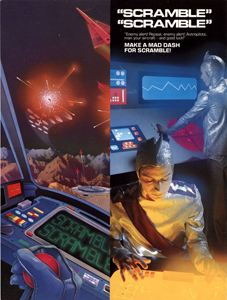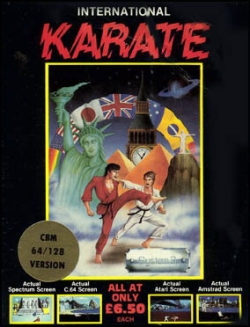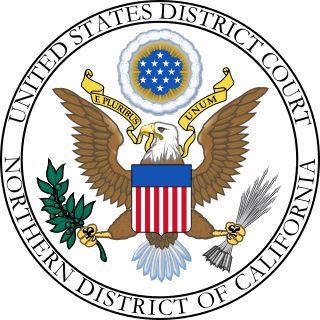
Scramble is a horizontally scrolling shooter arcade video game released in 1981. It was developed by Konami and manufactured and distributed by Leijac in Japan and Stern in North America. It was the first side-scrolling shooter with forced scrolling and multiple distinct levels, and it established the foundation for a new genre.
Software copyright is the application of copyright in law to machine-readable software. While many of the legal principles and policy debates concerning software copyright have close parallels in other domains of copyright law, there are a number of distinctive issues that arise with software. This article primarily focuses on topics particular to software.

K.C. Munchkin!, released in Europe as Munchkin, is a maze game for the Magnavox Odyssey 2. Its North American title is an inside reference to then president of Philips Consumer Electronics, Kenneth C. Menkin.
Fueled by the previous year's release of the colorful and appealing Pac-Man, the audience for arcade video games in 1981 became much wider. Pac-Man influenced maze games began appearing in arcades and on home systems. Pac-Man was the highest-grossing video game for the second year in a row. Nintendo's Donkey Kong defined the unnamed platform game genre, while Konami's Scramble established forced-scrolling shooters. The lesser known Jump Bug combined the two concepts into both the first scrolling platform game and the first platform shooter. Other arcade hits released in 1981 include Defender, Frogger, and the Galaxian sequel Galaga.

International Karate is a fighting game developed and published by System 3 for the ZX Spectrum in 1985 and ported to various home computers over the following years. In the United States it was published by Epyx in 1986 as World Karate Championship.

A video game clone is either a video game or a video game console very similar to, or heavily inspired by, a previous popular game or console. Clones are typically made to take financial advantage of the popularity of the cloned game or system, but clones may also result from earnest attempts to create homages or expand on game mechanics from the original game. An additional motivation unique to the medium of games as software with limited compatibility, is the desire to port a simulacrum of a game to platforms that the original is unavailable for or unsatisfactorily implemented on.

Midway Manufacturing Co. v. Artic International, Inc., 704 F.2d 1009, was a legal case where the United States Court of Appeals for the Seventh Circuit found that Artic violated Midway's copyright in their arcade games Pac-Man and Galaxian. The lawsuit was part of a trend of "knock-off" video games in the early 1980s, with courts recognizing that a video game can qualify for protection as a copyrighted audiovisual work.

Lewis Galoob Toys, Inc. v. Nintendo of America, Inc. is a 1992 legal case where the United States Court of Appeals for the Ninth Circuit concluded that there was no copyright infringement made by the Game Genie, a video game accessory that could alter the output of games for the Nintendo Entertainment System. The court determined that Galoob's Game Genie did not violate Nintendo's exclusive right to make derivative works of their games, because the Game Genie did not create a new permanent work. The court also found that the alterations produced by the Game Genie qualified as non-commercial fair use, and none of the alterations were supplanting demand for Nintendo's games.

The Digital Millennium Copyright Act (DMCA) is a 1998 United States copyright law that implements two 1996 treaties of the World Intellectual Property Organization (WIPO). It criminalizes production and dissemination of technology, devices, or services intended to circumvent measures that control access to copyrighted works. It also criminalizes the act of circumventing an access control, whether or not there is actual infringement of copyright itself. In addition, the DMCA heightens the penalties for copyright infringement on the Internet. Passed on October 12, 1998, by a unanimous vote in the United States Senate and signed into law by President Bill Clinton on October 28, 1998, the DMCA amended Title 17 of the United States Code to extend the reach of copyright, while limiting the liability of the providers of online services for copyright infringement by their users.

Sega Enterprises Ltd. v. Accolade, Inc., 977 F.2d 1510, is a case in which the United States Court of Appeals for the Ninth Circuit applied American intellectual property law to the reverse engineering of computer software. Stemming from the publishing of several Sega Genesis games by video game publisher Accolade, which had disassembled Genesis software in order to publish games without being licensed by Sega, the case involved several overlapping issues, including the scope of copyright, permissible uses for trademarks, and the scope of the fair use doctrine for computer code.

Data East USA, Inc. v. Epyx, Inc. 862 F.2d 204, 9 U.S.P.Q.2d (BNA) 1322 was a court case between two video game manufacturers, where Data East claimed that their copyright in Karate Champ was infringed by World Karate Championship, a game created by Epyx. Data East released Karate Champ in arcades in 1984, and the game became a best-seller and pioneered the fighting game genre. The next year, Epyx published World Karate Championship for home computers, which sold 1.5 million copies. Data East sued Epyx, alleging that the game infringed on their copyright and trademark.

Micro Star v. FormGen Inc. 154 F.3d 1107 is a legal case applying copyright law to video games, stopping the sales of a compilation of user-generated levels that infringed the copyright of Duke Nukem 3D. Micro Star downloaded the Duke Nukem 3D levels and re-packaged them as Nuke It, after seeing their popularity on the internet. Micro Star filed suit in the United States District Court for the Southern District of California, asking for declaratory judgment that they had not infringed any copyright. Game publisher FormGen counter-sued, claiming that Micro Star created a derivative work based on Duke Nukem 3D and infringed their copyright.

Sony Computer Entertainment v. Connectix Corporation, 203 F.3d 596 (2000), is a decision by the Ninth Circuit Court of Appeals which ruled that the copying of a copyrighted BIOS software during the development of an emulator software does not constitute copyright infringement, but is covered by fair use. The court also ruled that Sony's PlayStation trademark had not been tarnished by Connectix Corp.'s sale of its emulator software, the Virtual Game Station.

Atari Games Corp. v. Oman was a series of court cases where Atari, a video game developer, challenged the United States Copyright Office for refusing copyright registration for their arcade game Breakout. The Register of Copyrights first rejected Atari's registration in 1987, determining that Breakout lacked sufficient creativity to qualify as an audiovisual work. Atari twice appealed the register's decision before their copyright was granted. Decided in 1992, the case affirmed that video games are protected from clone developers who mimic a game's audiovisual aspects.
The protection of intellectual property (IP) of video games through copyright, patents, and trademarks, shares similar issues with the copyrightability of software as a relatively new area of IP law. The video game industry itself is built on the nature of reusing game concepts from prior games to create new gameplay styles but bounded by illegally direct cloning of existing games, and has made defining intellectual property protections difficult since it is not a fixed medium.

Tetris Holding, LLC v. Xio Interactive, Inc., 863 F.Supp.2d 394, was a 2012 American legal case related to copyright of video games, confirming that a game's look and feel can be protected under copyright law. Tetris Holding is a company that holds the copyright to the original Tetris game from 1985 and licenses those rights to game developers. Xio Interactive is a game developer that released Mino in 2009, a mobile game based on the gameplay of Tetris. Mino was downloaded millions of times, and Tetris Holding filed a DMCA notice and eventually a lawsuit against Xio for copyright infringement.

Capcom U.S.A. Inc. v. Data East Corp., 1994 WL 1751482 was a 1994 legal case related to the copyright of video games, where Capcom alleged that Data East's game Fighter's History infringed the copyright of Capcom's game Street Fighter II. It was revealed that the design documents for Fighter's History contained several references to Street Fighter II, leading Capcom to sue Data East for damages, as well as a preliminary injunction to stop the distribution of the infringing game. In spite of the intentional similarities between the two games, the court concluded that Data East did not infringe upon Capcom's copyright, as most of these similarities were not protected under copyright. Judge William H. Orrick Jr. applied a legal principle known as the merger doctrine, where courts will not grant copyright protection where it would effectively give someone a monopoly over an idea.

Atari, Inc. v. North American Philips Consumer Electronics Corp., 672 F.2d 607, is one of the first legal cases applying copyright law to video games, barring sales of the game K.C. Munchkin! for its similarities to Pac-Man. Atari had licensed the commercially successful arcade game Pac-Man from Namco and Midway, to produce a version for their Atari 2600 console. Around the same time, Philips created Munchkin as a similar maze-chase game, leading Atari to sue them for copyright infringement.

Atari Inc. v. Amusement World Inc., 547 F.Supp. 222 is a legal case in which the United States District Court for the District of Maryland held that Amusement World's arcade game Meteors did not violate Atari's copyright in their game Asteroids.












